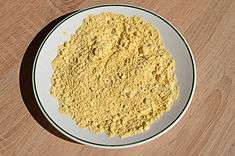Gram flour
Gram flour, besan is a pulse flour made from ground chickpeas. It is a staple ingredient in the cuisine of the Indian subcontinent, including in Indian, Bangladeshi, Burmese, Nepali, Pakistani, and Sri Lankan cuisines.
 | |
| Nutritional value per 100 g (3.5 oz) | |
|---|---|
| Energy | 1,619 kJ (387 kcal) |
57 g | |
| Sugars | 10 g |
| Dietary fiber | 10 g |
6 g | |
22 g | |
| Vitamins | Quantity %DV† |
| Niacin (B3) | 7% 1 mg |
| Folate (B9) | 109% 437 μg |
| Minerals | Quantity %DV† |
| Calcium | 5% 45 mg |
| Iron | 31% 4 mg |
| Magnesium | 47% 166 mg |
| Phosphorus | 45% 318 mg |
| Potassium | 18% 846 mg |
| Selenium | 11% 8 μg |
| Sodium | 4% 64 mg |
| Zinc | 21% 2 mg |
| Other constituents | Quantity |
| Water | 10 g |
| |
| †Percentages are roughly approximated using US recommendations for adults. Source: USDA Nutrient Database | |
Characteristics
Gram flour contains a high proportion of carbohydrates,[1] higher fiber relative to other flours, no gluten,[2] and a higher proportion of protein than other flours.[1]
Dishes
India
Gram flour is in popular use in the Indian subcontinent, where it is used to make the following:
- A variety of snacks
- Sev
- Bhajjis
- Bikaneri Bhujia
- Bonda
- Boondi
- Chakli
- Chila//Dhirda (besan dosa)
- Dhokla/Khaman
- Kadhi
- Zunka/Pithala/Pithla
- Laddu
- Soan papdi
- Mysore pak
- Pakoras
- Papadums
- Patra
In Andhra Pradesh, it is used in a curry with gram flour cakes called Senaga Pindi Kura (Telugu: శెనగ పిండి కూర) and is eaten with Chapati or Puri, mostly during winter for breakfast.[3] Chila (or chilla), a pancake made with gram flour batter, is a popular street food in India.
Southeast and East Asia
- Burmese tofu
- Jidou liangfen
Southern Europe
Along the coast of the Ligurian Sea, flour made from garbanzo beans, which are a different variety of chickpea closely related to Bengal gram, is used to make a thin pancake that is baked in the oven. This popular street food is called farinata in Italian cuisine, fainâ in Genoa, and is known as socca or cade in French cuisine. It is used to make panelle, a fritter in Sicilian cuisine. In Spanish cuisine, gram flour is an ingredient for tortillitas de camarones. Also in Cyprus and Greece, it is used as a garnishing ingredient for the funeral ritual food Koliva, blessed and eaten during Orthodox Memorial services. In the cuisine of Antakya in Turkey, it is used in the preparation of hummus.
North Africa
In Morocco, they make a dish called karan from gram flour and eggs, which is baked in the oven. A similar famous dish is prepared in Algeria called Garantita or Karantita (originated from the Spanish term Calentica, which means hot).[4]
Other uses
In the form of a paste with water or dahi (yogurt), it is also popular as a facial exfoliant in the Indian Subcontinent.[5] When mixed with an equal volume of water, it can be used as an egg replacement in vegan cooking.[6]
External links
See also
- List of chickpea dishes
- Oralu kallu, a type of grinding machine using stone to produce flour in some parts of India
- Kinako
Notes
- "Chickpea flour (besan)". Nutrition Data: Nutrition Facts and Calorie Counter. Retrieved 2007-09-29.
- "Grains and Flours Glossary: Besan". Celiac Sprue Association. Archived from the original on 2007-10-03. Retrieved 2007-09-29.
- "Senagapindi Kura (Onion curry with Besan)". Archived from the original on January 6, 2014. Retrieved January 6, 2014.
- Duclos, J. (1992). Le Pataouète. Dictionnaire de la langue populaire d'Algérie et d'Afrique du Nord (in French). Éd. Gandini. p. 50. ISBN 2906431117.
- "What is gram flour?". Blurtit.com. Retrieved 2007-09-29.
- The Vegan Society. "Egg Substitutes". Vegansociety.com. Archived from the original on 2011-07-16. Retrieved 2009-12-31.